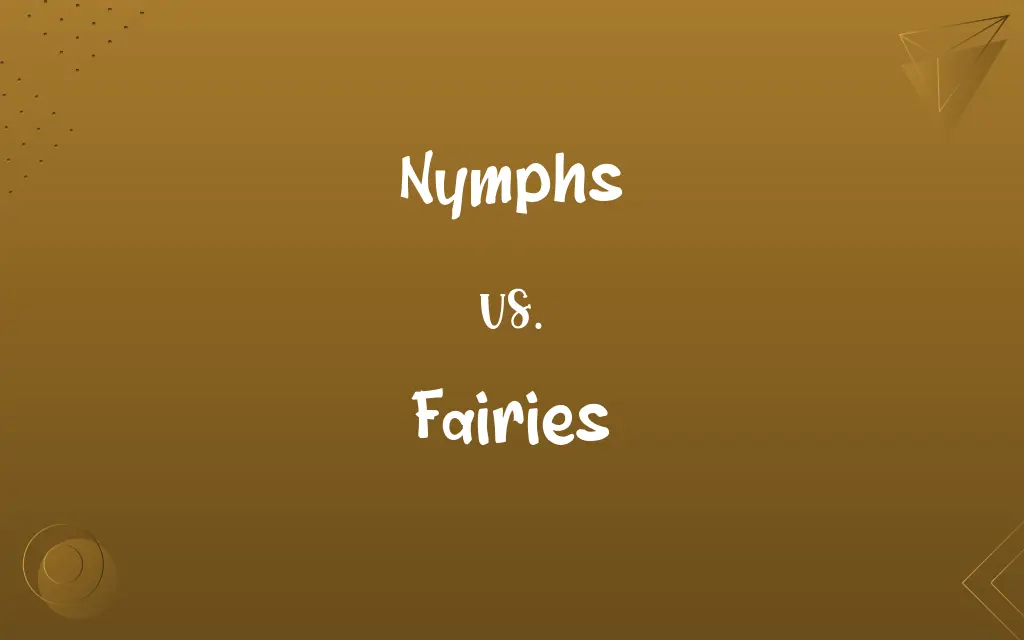Nymphs vs. Fairies: Know the Difference

By Shumaila Saeed || Published on February 1, 2024
Nymphs are nature spirits from Greek mythology, often associated with a specific place like a forest or river, while fairies, from European folklore, are magical, often mischievous beings with a wide range of powers and habitats.

Key Differences
Nymphs, originating from Greek mythology, are depicted as beautiful, young maidens associated with natural elements like water, trees, or mountains. Fairies, on the other hand, often found in European folklore, are magical creatures varying in appearance and size, known for their mischievous and sometimes malevolent behavior.
Shumaila Saeed
Feb 01, 2024
While nymphs are traditionally bound to specific natural locations or objects, such as a particular river or tree, fairies are more versatile in their associations, often found in various natural settings or even human homes. Nymphs are generally benevolent, closely tied to the life force of their associated element, whereas fairies can be unpredictable, sometimes helpful and other times harmful to humans.
Shumaila Saeed
Feb 01, 2024
Nymphs in mythology are not known for having extensive magical powers, their presence instead being a personification of nature's beauty and fertility. Fairies are depicted with a range of magical abilities, from casting spells to flying, and they often interact with humans, sometimes granting wishes or imposing curses.
Shumaila Saeed
Feb 01, 2024
In terms of visual representation, nymphs are usually portrayed as graceful, ethereal young women, often unclothed or draped in light, natural materials. Fairies are frequently depicted with wings, tiny statures, and whimsical, elaborate attire, distinguishing them from the more human-like appearance of nymphs.
Shumaila Saeed
Feb 01, 2024
Culturally, nymphs have been a subject of classical art and literature, symbolizing the idyllic and pastoral aspects of nature. Fairies have a broader cultural footprint, featuring prominently in children's tales, folklore, and modern fantasy literature and media, often embodying the magical and mysterious aspects of the natural world.
Shumaila Saeed
Feb 01, 2024
ADVERTISEMENT
Comparison Chart
Magical Powers
Limited to nature personification
Wide range, including spellcasting
Shumaila Saeed
Feb 01, 2024
ADVERTISEMENT
Nymphs and Fairies Definitions
Nymphs
Spirits residing within or representing individual trees.
The oak tree's nymph whispered secrets of the ancient forest.
Shumaila Saeed
Jan 16, 2024
Fairies
Fairies with the power to heal ailments.
The healing fairy used her magic to soothe the wounded bird.
Shumaila Saeed
Jan 16, 2024
Nymphs
Spirits embodying the essence of forests.
The forest nymphs danced in the moonlight, their laughter echoing through the trees.
Shumaila Saeed
Jan 16, 2024
Fairies
Magical beings connected to natural elements.
Nature fairies tended to the garden, keeping it lush and vibrant.
Shumaila Saeed
Jan 16, 2024
Nymphs
Divine entities associated with bodies of water.
Water nymphs could be seen beneath the surface, guiding the currents.
Shumaila Saeed
Jan 16, 2024
ADVERTISEMENT
Fairies
Small, helpful spirits inhabiting human homes.
The house fairy discreetly tidied up the room each night.
Shumaila Saeed
Jan 16, 2024
Nymphs
Guardians of mountainous regions in nature.
The mountain nymphs watched over the climbers, ensuring their safe passage.
Shumaila Saeed
Jan 16, 2024
Fairies
Mischievous fairies known for playing pranks.
The trickster fairy swapped the salt and sugar as a playful joke.
Shumaila Saeed
Jan 16, 2024
Nymphs
Representations of the vitality of meadows and grasslands.
Meadow nymphs frolicked among the wildflowers, celebrating spring.
Shumaila Saeed
Jan 16, 2024
Fairies
Protectors of individuals or places.
A guardian fairy watched over the sleeping child, keeping nightmares at bay.
Shumaila Saeed
Jan 16, 2024
Nymphs
Greek & Roman Mythology Any of numerous minor deities represented as beautiful maidens inhabiting and sometimes personifying features of nature such as trees, waters, and mountains.
Shumaila Saeed
Jan 16, 2024
Fairies
An imaginary being in human form, depicted as clever, mischievous, and possessing magical powers.
Shumaila Saeed
Jan 16, 2024
Nymphs
The immature form of an insect, such as a grasshopper, that does not pass through a pupal stage during metamorphosis. Nymphs resemble adults but are smaller and lack fully developed wings.
Shumaila Saeed
Jan 16, 2024
Nymphs
The eight-legged immature form of certain arachnids, such as ticks and mites.
Shumaila Saeed
Jan 16, 2024
Repeatedly Asked Queries
What are fairies?
Fairies are mythical beings from folklore, known for their magical powers and often depicted as tiny, human-like creatures with wings.
Shumaila Saeed
Feb 01, 2024
Where do nymphs reside?
Nymphs are often associated with specific natural elements, such as forests, rivers, mountains, or trees.
Shumaila Saeed
Feb 01, 2024
Can fairies be mischievous?
Yes, fairies are often portrayed as mischievous or even malevolent, known for playing pranks or casting spells.
Shumaila Saeed
Feb 01, 2024
Do nymphs have magical powers?
Nymphs are more symbolic representations of nature's beauty and fertility rather than beings with extensive magical powers.
Shumaila Saeed
Feb 01, 2024
Are nymphs immortal?
In mythology, nymphs are often considered long-lived or immortal, closely tied to the lifespan of their natural element.
Shumaila Saeed
Feb 01, 2024
How do fairies interact with humans?
Fairies can interact with humans in various ways, sometimes helping them, granting wishes, or causing trouble.
Shumaila Saeed
Feb 01, 2024
Do fairies have a universal appearance?
The appearance of fairies varies widely in folklore, but they are often depicted as small, with whimsical attire and wings.
Shumaila Saeed
Feb 01, 2024
What are nymphs?
Nymphs are nature spirits from Greek mythology, typically depicted as beautiful, young women associated with natural elements.
Shumaila Saeed
Feb 01, 2024
What is the role of water nymphs?
Water nymphs are seen as guardians or personifications of rivers, lakes, and other water bodies.
Shumaila Saeed
Feb 01, 2024
Are fairies always benevolent?
Fairies are not always benevolent; their behavior ranges from helpful and protective to mischievous or harmful.
Shumaila Saeed
Feb 01, 2024
Can fairies fly?
Many fairy depictions include wings, allowing them to fly, which is a common trait in fairy lore.
Shumaila Saeed
Feb 01, 2024
Are fairies part of children’s stories?
Fairies are a popular element in children's tales and folklore, often bringing a sense of magic and wonder.
Shumaila Saeed
Feb 01, 2024
Can nymphs leave their natural habitat?
In most myths, nymphs are bound to their specific natural element or location and rarely leave it.
Shumaila Saeed
Feb 01, 2024
Do fairies have a hierarchy or society?
Some folklore and literature depict fairies as having complex societies or hierarchies, with queens and courts.
Shumaila Saeed
Feb 01, 2024
Do nymphs appear in classical literature?
Yes, nymphs are prominent in Greek and Roman literature, often representing the idyllic aspects of nature.
Shumaila Saeed
Feb 01, 2024
Do nymphs interact with gods or heroes in myths?
Nymphs often appear in myths interacting with gods and heroes, sometimes as companions or helpers.
Shumaila Saeed
Feb 01, 2024
How do fairies communicate?
Fairies are often portrayed as having their own language or magical means of communication, sometimes understandable by humans.
Shumaila Saeed
Feb 01, 2024
Are there different types of nymphs?
Yes, there are various types of nymphs, such as dryads (tree nymphs), naiads (water nymphs), and oreads (mountain nymphs).
Shumaila Saeed
Feb 01, 2024
What is the cultural significance of nymphs?
Nymphs symbolize the natural beauty and vitality of the world, often celebrated in art and poetry.
Shumaila Saeed
Feb 01, 2024
Do fairies appear in modern media?
Fairies are a popular element in modern fantasy literature, movies, and TV shows, often with unique interpretations.
Shumaila Saeed
Feb 01, 2024
Share this page
Link for your blog / website
HTML
Link to share via messenger
About Author
Written by
Shumaila SaeedShumaila Saeed, an expert content creator with 6 years of experience, specializes in distilling complex topics into easily digestible comparisons, shining a light on the nuances that both inform and educate readers with clarity and accuracy.









































































